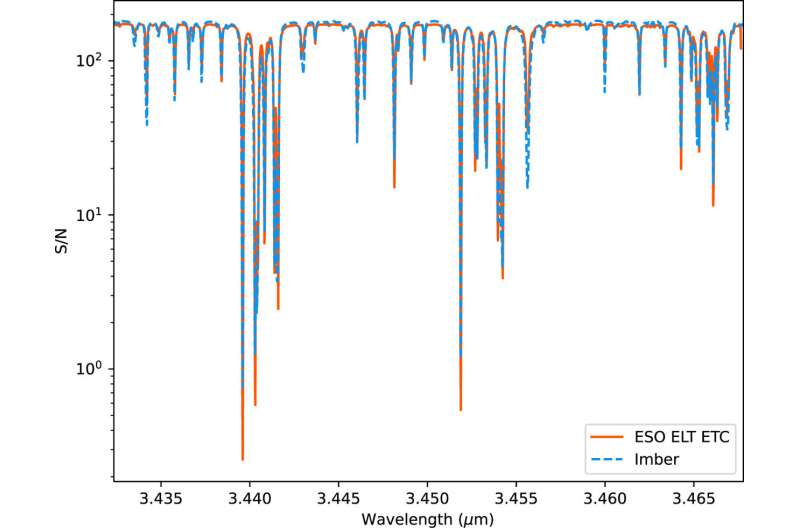This article has been reviewed according to Science X's editorial process and policies. Editors have highlighted the following attributes while ensuring the content's credibility:
fact-checked
peer-reviewed publication
trusted source
proofread
Using cosmic weather to study which worlds could support life

As the next generation of giant, high-powered observatories begin to come online, a new study suggests that their instruments may offer scientists an unparalleled opportunity to discern what weather may be like on far-away exoplanets.
Dubbed the extremely large telescopes (ELTs), these observatories, which include the Extremely Large Telescope (ELT), the Giant Magellan Telescope (GMT), and the Thirty Meter Telescope (TMT), will be some of the largest ground-based telescopes ever built, and their instruments are expected to exceed the capabilities of the James Webb Space Telescope.
Data collected with their powerful instruments will allow astronomers to use Doppler Imaging—a technique that can recreate 2D maps of an object's surface—to make accurate measurements of the magnetism and chemistry of ultracool targets, or cosmic objects with temperatures less than 2700 K, such as brown dwarfs (BDs) or very low-mass stars (VLMs)— and even some exoplanets.
Besides helping to improve our understanding of some of the most mysterious objects in the universe, having the capability to study the chemical compositions of these objects in a more precise manner also offers greater insight into the search for life on other worlds, said Michael Plummer, lead author of the study and a graduate student in astronomy at The Ohio State University.
"Learning about the atmospheres of other objects outside our solar system not only informs us how Earth's atmosphere may behave but allows scientists to scale those concepts to study potentially habitable planets," said Plummer.
The study was published this month in the Astrophysical Journal.
Magnetism is especially important to search for worlds similar to our own as magnetic fields, specifically for smaller star systems, are considered necessary to support and influence whether a planet can support life on its surface.
To aid in this hunt, Plummer and Ji Wang, co-author of the study and an assistant professor of astronomy at Ohio State, previously developed a publicly available analytical code called Imber to simulate and infer the presence of surface discrepancies like magnetic star spots, cloud systems, and other atmospheric phenomena such as hurricanes on distant objects.
In this study, they used the technique to estimate the scientific capabilities of various ELTs' instruments to detect surface variations on six targets: the star of Trappist-1, a well-studied seven-planet system about 40 light-years from Earth, two brown dwarfs, and three exoplanets.
They used their technique to investigate the abilities of the following instruments: the GMT's Consortium Large Earth Finder (GMT/GCLEF), the ELT's Mid-Infrared ELT Imager and Spectrograph (ELT/METIS) and the TMT's Multi-Objective Diffraction-limited High-Resolution Infrared Spectrograph (MODHIS).
Researchers found that while discerning star spots on Trappist-1 was challenging for all three instruments due to its edge-on inclination—or its orbit in parallel to the rest of the sky—ELT and TMT could make high-resolution observations of the brown dwarfs and exoplanets over a single rotation.
Conversely, GMT's instruments required multiple rounds of observations to determine the presence of surface irregularities on the study's chosen exoplanets. Overall, the study shows that their technique can provide an accurate estimation of ELTs future abilities and help determine if future targets would be worth investigating on a larger scale.
Plummer also said their technique garnered interest from scientists looking to identify or confirm planetary bodies found using the radial velocity method—a way to find exoplanets by studying the slight gravitational effect an object has on the star it orbits. In essence, their research is the first step towards helping scientists use future astronomical instruments to the best of their abilities.
"The more we learn about other similar planets to Earth, the more those discoveries should inform Earth science itself," said Plummer. "Our work is particularly well-suited to help make those real-world observations."
More information: Michael K. Plummer et al, Mapping the Skies of Ultracool Worlds: Detecting Storms and Spots with Extremely Large Telescopes, The Astrophysical Journal (2023). DOI: 10.3847/1538-4357/accd5d
Journal information: Astrophysical Journal
Provided by The Ohio State University





















